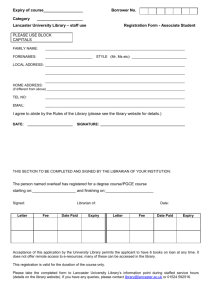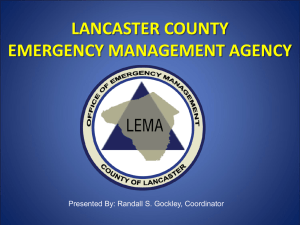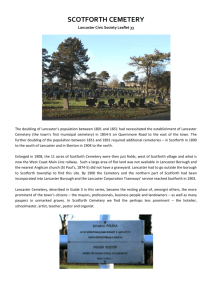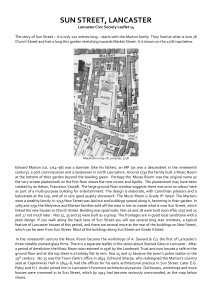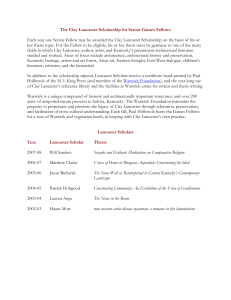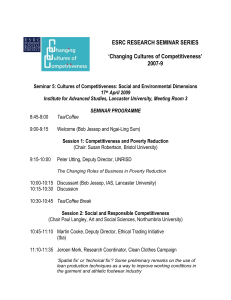Lancaster Cemetery: History, Burials & Architecture
advertisement
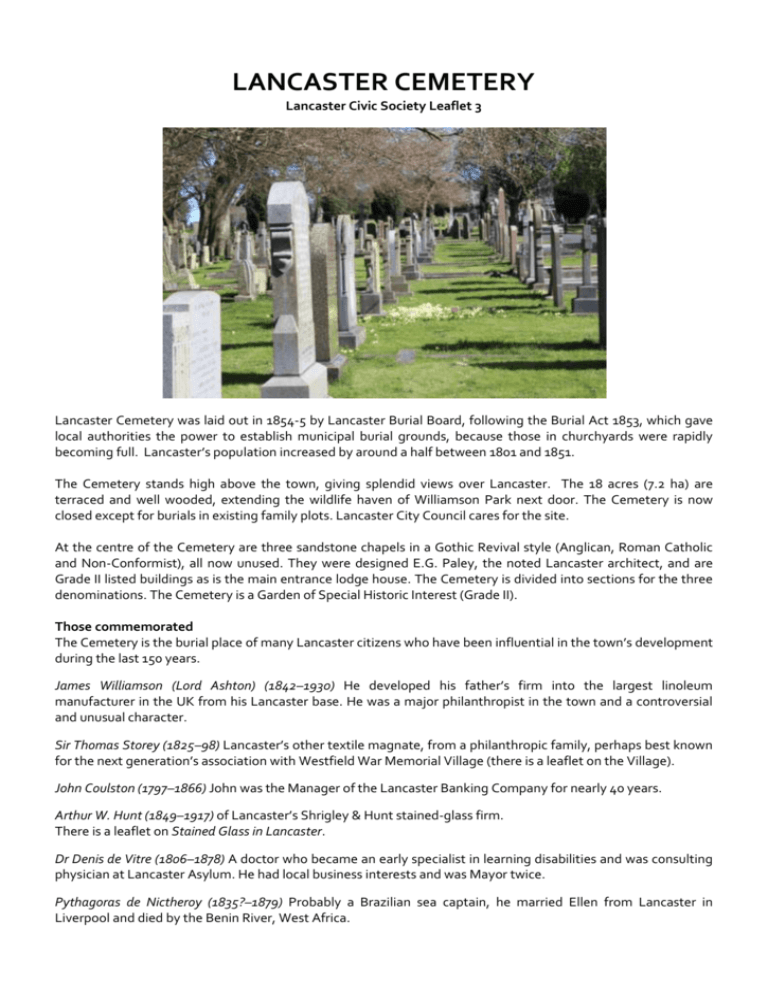
LANCASTER CEMETERY Lancaster Civic Society Leaflet 3 Lancaster Cemetery was laid out in 1854-5 by Lancaster Burial Board, following the Burial Act 1853, which gave local authorities the power to establish municipal burial grounds, because those in churchyards were rapidly becoming full. Lancaster’s population increased by around a half between 1801 and 1851. The Cemetery stands high above the town, giving splendid views over Lancaster. The 18 acres (7.2 ha) are terraced and well wooded, extending the wildlife haven of Williamson Park next door. The Cemetery is now closed except for burials in existing family plots. Lancaster City Council cares for the site. At the centre of the Cemetery are three sandstone chapels in a Gothic Revival style (Anglican, Roman Catholic and Non-Conformist), all now unused. They were designed E.G. Paley, the noted Lancaster architect, and are Grade II listed buildings as is the main entrance lodge house. The Cemetery is divided into sections for the three denominations. The Cemetery is a Garden of Special Historic Interest (Grade II). Those commemorated The Cemetery is the burial place of many Lancaster citizens who have been influential in the town’s development during the last 150 years. James Williamson (Lord Ashton) (1842–1930) He developed his father’s firm into the largest linoleum manufacturer in the UK from his Lancaster base. He was a major philanthropist in the town and a controversial and unusual character. Sir Thomas Storey (1825–98) Lancaster’s other textile magnate, from a philanthropic family, perhaps best known for the next generation’s association with Westfield War Memorial Village (there is a leaflet on the Village). John Coulston (1797–1866) John was the Manager of the Lancaster Banking Company for nearly 40 years. Arthur W. Hunt (1849–1917) of Lancaster’s Shrigley & Hunt stained-glass firm. There is a leaflet on Stained Glass in Lancaster. Dr Denis de Vitre (1806–1878) A doctor who became an early specialist in learning disabilities and was consulting physician at Lancaster Asylum. He had local business interests and was Mayor twice. Pythagoras de Nictheroy (1835?–1879) Probably a Brazilian sea captain, he married Ellen from Lancaster in Liverpool and died by the Benin River, West Africa. Sharpe, Paley and Austin, of the notable Lancaster architectural practice, are all here. So are surgeons, lawyers, a town clerk and several mayors. There are the Keeper of Lancaster Castle, hotel owners, drapers, a stationmaster and grocer. Note the monument – one of few – to the casualties of the Crimean War (1853–56) – “the imperishable memory”. It is of limestone, designed by E.G. Paley in 1860, paid for by public subscription and is Grade II listed. Over 100 casualties of the two World Wars are also buried here in Commonwealth War Graves. Along the west side and in the northeast corner are the paupers’ graves, unmarked, for all those whose families could not afford a gravestone. The styles As you walk around you will see a wide variety of styles of stonework – Celtic, Gothic, Art Nouveau and Art Deco. The stonework takes many forms – obelisks, columns, crosses, vertical and horizontal slabs and sarcophagi. Some of the stone carving mimics books, scrolls, crosses made from logs or natural limestone formations. The lettering on the gravestones – engraved or inserted lead work – also follows the styles of the last 170 years. The symbols Many of the gravestones have carvings with traditional symbolic meanings. An angel – God’s messenger A book – The Bible A closed book – a life ended A broken column – a life cut short A shroud – for sorrow A palm frond – victory over death A dove – a soul ascending, purity Oak leaves – strength Ivy – eternity Grapes – Christ’s blood A cross – faith and resurrection. Doors, gates – to Heaven A lamb – innocence A lily – beauty A rose – martyrdom An anchor – hope and safety A wreath – victory in death A draped urn – grief Rope – linking Heaven and Earth, the living and dead Crimean War Memorial James Williamson, Baron Ashton Lancaster Cemetery is on Quernmore Road – for satnav use LA1 3JT. Text – Roger Frankland and Gordon Clark. Photographs – Gordon Clark. Published by Lancaster Civic Society (© 2014). www.lancastercivicsociety.org www.citycoastcountryside.co.uk
